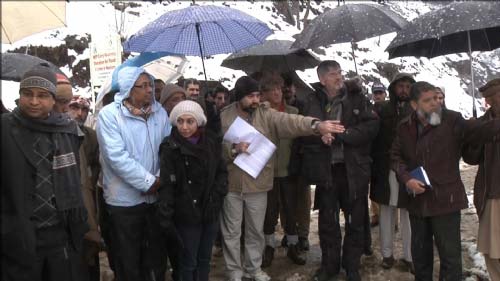They fought over “reasonable hospitality”, confidentiality issues and could not write a joint report to a joint inspection of the two controversial power projects they are building on either side of the LoC. Since May 2010, their only agreement was to disagree. But the intensely interesting arbitration of the Kishanganga case indicates Islamabad has lost its case, so has India on another front, reports R S Gull

It was a mad race for investments by Pakistan’s Water and Power Development Authority (WAPDA) and India’s National Hydroelectric Power Corporation (NHPC). Desperate to harvest the mountain river that India calls Kishanganga and Pakistan Neelum, both the countries wanted to the use the waters for power generation. In Gurez, NHPC planned 330-MW Kishanganga project (being implemented by HCC) and in Nauseri, in Muzaffarabad outskirts, WAPDA planned a 969 MW project taking (awarded to Chinese consortium CGGC-CMEC). NHPC would take the water from Gurez dam through a 22 kms tunnel to Bandipore, generate power and discharge in Wullar. WAPDA planned a 32 kms tunnel to divert most of Jhelum and returned the water to the river.
Islamabad had major problems with the Kishanganga Hydroelectric Power project (KHEP). Pakistan’s stand was the diversion will create a situation that Kishanganga waters will discharge into Jhelum almost 100 Kms ahead of its natural confluence in Muzaffarabad outskirts which will force a crop pattern in 100 kms. Besides, it will reduce the output of its Neelam Jhelum Hydro Electric Project (NJHEP) significantly. Both sides talked for six years and failed. Finally, Pakistan took the “dispute” to The Hague for arbitration in May 2010.
While fighting the case in The Hague, the two countries put their projects in the fast phase. Both the sides were working on the belief that the project which will be ready first will be protected by the provisions of the Treaty. It happened exactly but in reverse order. The International Court of Arbitration (ICA) sought details and history of the twin projects to establish the “critical period” in which the parties “not only planned the projects but took concrete steps toward their realization”. On this analysis, the Court concluded that the KHEP reached this period in 2004–2006 and NJHEP in 2007 and 2008. “Given this timing, the Court decided that India’s right to divert the waters of the Kishenganga / Neelum by the KHEP is protected by the Treaty.”

The International Court of Arbitration at The Hague in the courtroom at Peace Palace.
The final award of the seven-member ICA led by Judge Stephen Myron Schwebel is expected to be out by December 2013. The court already has visited the twin sites twice on either side of the LoC in June 2011 and February 2012. Its ‘partial award’ released on Monday last has lifted all the restrictions that were part of September 23, 2011 order that had permitted NHPC to do everything on its project without fiddling with the river bed.
What is most significant that the award expressly upheld India’s right to inter-tributary transfer, the main part of the dispute. The order says the Indus Water Treaty does not prohibit it. On the facts of the case the KHEP, the court ruled, should be regarded as located on the Kishenganga / Neelum notwithstanding that its powerhouse is situated at a distance of 23 kms from that river. By releasing water into the Bonar Nallah after it has passed through the powerhouse, the KHEP complies with the requirement that the “water released below the Plant” be delivered “into another Tributary.” Finally, the Court found that the KHEP’s inter-tributary transfer is “necessary,” as required by the Treaty, for the generation of hydroelectric power, as power can be generated on the scale contemplated by India in this location only by using the 665 metre difference in elevation between the dam site on the Kishenganga / Neelum and the place where the water is released into the Bonar Nallah.
The three-point decision on the first part of the dispute recognizes KHEP as a Run-of-River Plant, permits India to divert water from the Kishenganga / Neelum River for power generation and deliver the water released below the power station into the Bonar Nallah. This all is conditional. “India is however under an obligation to construct and operate the Kishenganga Hydro-Electric Plant in such a way as to maintain a minimum flow of water in the Kishenganga/Neelum River, at a rate, to be determined by the Court in a Final Award,” the order reads.
The court, however, did not give India absolute rights for diverting the water. “It is subject to the constraints specified in the Treaty and, in addition, by the relevant principles of customary international law,” the court ruled. “Pakistan retains the right to receive a minimum flow of water from India in the Kishenganga / Neelum riverbed at all times.” ICA deferred its determination of the appropriate minimum flow to a Final Award, and requested the Parties to provide additional data concerning the impacts of a range of minimum flows at the KHEP by June 2013.
Pakistan had put up a fierce fight saying dam and powerhouse of KHEP are located in two different catchment areas and India skipped carrying out any environmental impact study downstream. India denied Pakistan offering any details about the impact barring its 133,000 hectors of irrigated land may suffer but did not explain in detail.
Excited, as they should be, the officials in NHPC and the state’s fully owned Power Development Corporation (PDC) have started working on the windfall the existing projects will witness by way of additional generation. “The ICA has just tackled the legal part of the case,” an excited officer in state’s energy sector said. “The technical part is yet to be taken up.”
In anticipation of the final order, NHPC and PDC, the two main players in state’s energy sector, have drawn up their plans. Both the players can add to their capacities and increase generation by an estimated 500 million units a year.
PDC is planning an additional unit in the 105 MW Lower Jhelum Power Project. “The order will make many things happen now,” Basharat Ahmad, MD of state’s Power Development Corporation (PDC) said. “We are in the process of drafting a DPR for adding another 35-MW unit to the Lower Jhelum Project,” Ahmad said. At the most, he said, the power canal would require a bit of improvement so that additional load would be added to it.

As for NHPC, it will have more water available for its twin projects the 480-MW Uri-I and the 240-MW Uri-II. While the first project is debt free and in profit, the second project is at an advanced stage of implementation and might go into generation by latter 2013. Officials said Uri-II could now be upgraded to 480 MW as NHPC will be the principal beneficiary because it could be richer by 312.62 million units a year
The inter-tributary transfer of water, that the ICA permitted, would raise the level of the Wullar lake and provide 52 cubic meters more water to downstream three projects. But now the crucial issue is what is the quantum of water that ICA will permit to be diverted from Kishanganga to Bunar Madumati Nullah in Bandipore and eventually to Wullar lake. Till this figure is not available, the ambitious plans may not be taken seriously. But insiders in the energy sector said they would slightly less than one-third of Kishanganga water to realize the dream of capacity additions.
Kishanganga is a mountain rivulet that flows between J&K and PaK and is de facto LoC for a vast stretch between Gurez in Bandipore to Karnah in Kupwara. It has peak discharge is summer because of the snowmelt and remains sluggish for rest of the year.
But that is just one part of the story. The other is not so encouraging for Delhi. Using her rights within the Indus Water Treaty, Islamabad went to The Hague with two points. The first was the legality of diverting the water and it is settled now, albeit partially. The second dispute before the ICA was not less crucial: “Whether under the Treaty, India may deplete or bring the reservoir level of a run-of-river Plant below Dead Storage Level (DSL) in any circumstances except in the case of unforeseen emergency?”
This slightly technical issue needs a bit of explanation. Dams or water reservoirs of power projects face sedimentation problem, everywhere. At the time of the signing of Indus Water Treaty, there was no mechanism available for sediment control. Soon after the Treaty, a technology was devised for the drawdown flushing of the sediment load. It envisages having gates in the dam that drain from the bottom of it thus flushing sediment load out.
Islamabad ferociously opposed adoption of this sluicing technology. This was why, NHPC run 900-MW Salal lacks this facility and it has created a situation that managing sediments is a messy affair. NHPC invests every year to manage the dam. When PDC started implementing 450-MW Baghliar, the same issue cropped up and Islamabad took the case to Neutral Expert appointed by the World Bank. The award came in Baglihar’s favour. The same technology was denied to the NHPC in Dul-Husti power project in Kishtwar.
As the Kishanganga issue was sent to ICA, the issue cropped up again. For Pakistan, the partial award notes, the drawdown flushing of a reservoir necessarily affects the rate and timing of the flow below the dam – increasing the flow as water is released from the reservoir and reducing the flow when the reservoir is subsequently refilled. Its prohibition in the Treaty is essential to securing Pakistan’s uninterrupted use of the flow of water in the downstream stretches of the Western Rivers, an objective that Pakistan considers to be one of the Treaty’s vital aims.
After a protracted debate that envisages even a challenge to the status of the dispute, ICA considered it in detail. Its four-point verdict made it clear that except in “an unforeseen emergency”, the Treaty does not permit reduction below Dead Storage Level of the water level in the reservoirs of Run-of-River Plants. It expressly stated that “accumulation of sediment in the reservoir” does not constitute an “unforeseen emergency” that would permit the depletion of the reservoir below DSL for drawdown flushing purposes. It forbade India from opting for this option. However, this order is not applicable to Plants in operation or projects under construction, the design of which, having been duly communicated by India to Pakistan. This order will be a major crisis for the future projects in J&K the rivers of which carrying massive sediment loads, especially the Chenab, the main powerhouse of the state.
The victory that Islamabad is claiming over the verdict lies in this part of the award. Pakistani water experts insist that while the verdict will make India to change the design of KHEP, it will safeguard Pakistan’s interest in future. At the same time, however, the quantification of the water sharing of Kishanganga will determine whether NJHEP might have to undergo design changes. The partial ward is binding on both parties with no right to appeal.















